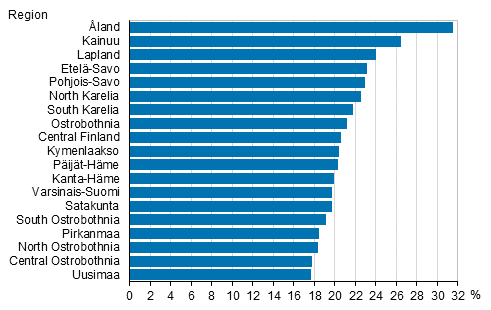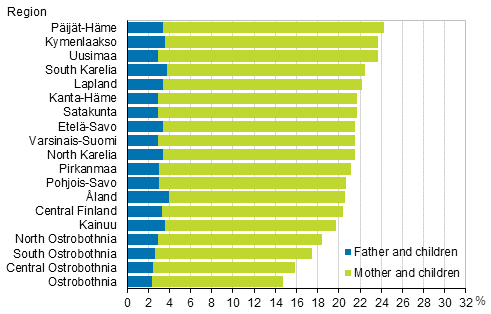4. Generality of family types varies by region
4.1 Number of cohabiting couples highest in Åland and Kainuu
The commonest type of family with children in all regions is one of a married couple although clear differences can also be detected. The differences arise from the prevalence of families of cohabiting couples and one-parent families in the regions. In relative numbers, most cohabiting couples are found in Åland, Kainuu and Lapland. In Åland, 32 per cent, in Kainuu, 27 per cent and in Lapland, 24 per cent of all families with underage children are families of cohabiting couples. The lowest share of cohabiting families in Finland is found in Uusimaa, 18 per cent.
Figure 7. Families of cohabiting couples as a proportions of families with underage children by region in 2016

When examining the prevalence of cohabiting couples by municipality, the municipalities of Åland are in the lead. Among municipalities in Mainland Finland, Pelkosenniemi holds the lead with 37 per cent of families with underage children cohabiting. After Pelkosenniemi, the number of families of cohabiting couples was in relative terms highest in Luhanka (35%). The municipality in Mainland Finland with the lowest share of seven per cent of families of cohabiting couples with children is Luoto.
4.2 Ostrobothnian regions have the lowest number of one-parent families in relative terms
There is also clear regional variation in the prevalence of one-parent families. The number of one-parent families is lowest in relative terms in the region of Ostrobothnia, 15 per cent of families with children (Figure 8). The number of one-parent families is highest in Päijät-Häme (24.2%), Kymenlaakso (23.7%) and Uusimaa (23.7%).
Figure 8. Proportion of single-parent families of all families with underage children by region in 2016

The regional variation in the proportion of one-parent families with children is mostly due to the different proportions of families of the type mother and children. The proportion of families of the type father and children ranges from two to four per cent in all regions. The proportions are biggest in Åland (4.0%), South Karelia (3.8%) and Kainuu (3.6%).
Examined by municipality in Mainland Finland, the proportions of one-parent families with children are highest in Harjavalta (28.2%), Hartola (28.0%) and Helsinki (27.8%). The percentages are also high in several of Åland's municipalities, but most of the municipalities are so small that a change of a few family types may change the percentages much. The share of one-parent families was 27 per cent in Mariehamn.
In relative terms, Luoto (4.6%) and Pedersöre (6.5%) have the lowest number of one-parent families with underage children in Mainland Finland.
Luoto could be viewed as the most conventional municipality in terms of family structure, because it has the lowest proportion of one-parent families with children (4.6%) and the highest proportion of married couples (88.9%) in the whole country. Luoto also has the ninth highest average number of 2.7 underage children living at home per family. The number of underage children living at home was highest in Lumijoki, Perho and Sievi, 3.0, on average. The average for the whole country is 1.8.
Source: Population and Justice Statistics, Statistics Finland
Inquiries: Marjut Pietiläinen 029 551 2798, Timo Nikander 029 551 3250, Joonas Toivola 029 551 3355, info@stat.fi
Director in charge: Jari Tarkoma
Updated 24.11.2017
Official Statistics of Finland (OSF):
Families [e-publication].
ISSN=1798-3231. Annual Review 2016,
4. Generality of family types varies by region
. Helsinki: Statistics Finland [referred: 19.4.2025].
Access method: http://stat.fi/til/perh/2016/02/perh_2016_02_2017-11-24_kat_004_en.html

